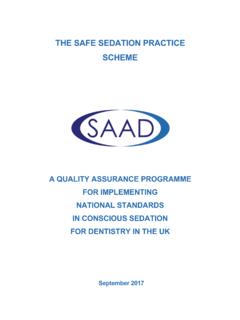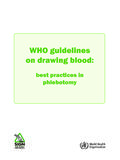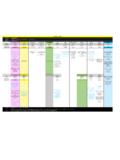Transcription of Standards for Conscious Sedation in the Provision of ...
1 Standards for Conscious Sedation in the Provision of Dental CareThe dental faculties of the royal colleges of surgeons and the Royal College of Anaesthetists2015 Report of the Intercollegiate Advisory Committee for Sedation in Dentistry2 Executive summary ..03 Committee members ..04 Foreword ..06 Introduction ..07 Options for care ..08 Preparation for Sedation ..10 Consent for treatment ..10 Patient information ..11 Fasting ..12 Clinical environment for Sedation ..13 Nature of the clinical team for Sedation ..14 Techniques of Sedation ..15 Essential principles of safe Sedation practice ..15 Specific techniques ..16 Peri-operative care ..18 Monitoring ..18 Complications ..18 Recovery, discharge and aftercare.
2 19 Clinical governance and audit ..20 Education and training ..21 SectionsSection 1: care pathways ..23 Section 2: Clinical Sedation techniques ..25 Section 3: Peri-operative care ..30 Section 4: Patient information ..32 Section 5: Education and training ..34 AppendicesAppendix 1 ..36 Training in Conscious Sedation : generic learning outcomes ..36 Syllabus 1: Dentists: Basic Conscious Sedation techniques for children, young people and adults ..38 Syllabus 2: Dentists: Advanced Conscious Sedation for young people and adults ..48 Syllabus 3: Dentists: Advanced Conscious Sedation for children ..56 Syllabus 4: Dental therapists and dental hygienists: Inhalation Sedation ..66 Syllabus 5: Dental nurses: Assisting during Conscious Sedation .
3 75 Appendix 2 ..86 Course accreditation ..86 Transitional arrangements ..87 Appendix 3 ..88 Examples of patient information ..88 References ..114 FiguresFigure 1: The options for managing dental anxiety ..09 Figure 2: A care pathway for children and young people aged 0 16 years ..24 TablesTable 1: Requirements for clinical Sedation techniques ..26 Table 2: Intra-operative care and monitoring ..31 ContentsCONTENTS3 EXECUTIVE SUMMARY1. This report creates a national standard for the use of Conscious Sedation in the delivery of dental care . The Standards apply to all who practise Conscious Sedation techniques, whether they are dentists, doctors, nurses or dental care Conscious Sedation is an important modality that forms one strand of the delivery of dental care to patients who have significant anxiety.
4 This document describes the clinical techniques that are available for Conscious Sedation in dentistry and the appropriate environments for their The report defines the age of a child as being an individual of under 12 years in respect of the delivery of Conscious Sedation . It is recognised that a numerical definition has limitations when considering both physical and mental maturity. The clinical team and facilities required for the dental treatment of younger patients under Conscious Sedation are defined in this report. It is recognised that significant development and investment will be required to meet these Dental care is provided for the benefit of our patients. This report makes recommendations about ensuring that they receive the best care , which requires that the healthcare team makes available both verbal and written information of high quality in a form that is easily assimilated by patients, their parents or Patients have the right to expect a high quality service to meet their dental needs.
5 This can only be achieved through robust, validated education and training of the entire dental team. Educational or training courses that teach clinical techniques preparing individuals for independent practice must include supervised clinical practice. The requirement for high quality education underpins the The requirements for high quality education, which include supervised clinical practice, may limit the number of providers that are able to provide training Sedation services must demonstrate a high level of safety and a continuing improvement in quality. The use of appropriate audit tools to review clinical outcomes is an essential component of good clinical practice. Careful and reflective use of such data will enhance patient safety and improve the quality of It is recommended that a system for reporting adverse events in the delivery of Conscious Sedation in dentistry be developed for those working in independent practice.
6 This should parallel systems currently used in National Health Service (NHS) The report recognises the need for healthcare professionals not only to gain knowledge and skills but also to maintain and further develop them. Individuals who wish to practise Conscious Sedation must undergo regular continuing education in the techniques that they use. Those using a technique of Conscious Sedation infrequently should consider whether it is in the best interests of patients for them to continue to use All centres providing Conscious Sedation for the delivery of dental care should be inspected to determine that the necessary Standards are in place. This is currently the responsibility of the relevant agencies in each country in the It is recognised that some of the recommendations of this report will have far-reaching consequences.
7 Implementation may have significant implications for providers and for those who commission dental clinical services but safety of patients is our summary4 Committee membersCOMMITTEE MEMBERSP rofessor Richard Ibbetson Chairman of the Committee, Faculty of Dental Surgery, Royal College of Surgeons of EdinburghDr Mike Blayney Royal College of Anaesthetists (alternate member)Mrs Vanita Brookes Chair, Specialist Advisory Committee for Special care Dentistry (2014 onwards)Professor Jonathan Cowpe Chair, Joint Committee for Postgraduate Training in Dentistry (2011 2013 )Dr David Craig Dental Sedation Teachers GroupDr David Felix Chair, Joint Committee for Postgraduate Training in Dentistry (2013 onwards ) Professor Nick Girdler Faculty of Dental Surgery, Royal College of Surgeons of EnglandMrs Karen Gordon Chair, Specialist Advisory Committee for Special care Dentistry (2011 2014)Ms Tina Gorman National Examining Board for Dental Nurses.
8 Representing the Lead Dean for Dental care Professionals, Council of Postgraduate Dental Deans and DirectorsMr Bryan Harvey Dental Defence UnionMr Richard Hayward Faculty of General Dental Practice (UK)Mr Christopher Holden Society for the Advancement of Anaesthesia in Dentistry (alternate member)Mrs Isabelle Holroyd British Society of Paediatric DentistryDr Sarah Manton Faculty of Dental Surgery, Royal College of Surgeons of EdinburghDr Avril Neilson Faculty of Dental Surgery, Royal College of Physicians and Surgeons of GlasgowMrs Kate Rivett Patient Representative, Joint Dental FacultiesDr Nigel Robb Society for the Advancement of Anaesthesia in DentistryDr Anna-Maria Rollin Royal College of Anaesthetists5Mr Nicholas Taylor Postgraduate Dental Dean, Health Education EnglandDr Kathy Wilson Faculty of Dental Surgery, Royal College of Surgeons of England (alternate member)
9 General Dental Council Ms Maria Burke Administrator and Committee Manager, Royal College of Surgeons of England (2011 2013)Mr Neil Sutcliffe Administrator and Committee Manager, Royal College of Surgeons of England (2013 onwards)Co-opted memberDr Yvonne Hurst Head of Education, Royal College of Surgeons of EdinburghObserversProfessor Jenny Gallagher Consultants in Dental Public Health GroupProfessor June Nunn Faculty of Dentistry, Royal College of Surgeons in IrelandDr Sue Gregory Department of Health, EnglandDr Tom Schnittger College of Anaesthetists of Ireland (co-opted)Corresponding membersChief Dental Officers of the devolved nations (Scotland, Wales and Northern Ireland)General Medical Council6 This publication creates a national standard for Conscious Sedation in dentistry and replaces the previous documents Conscious Sedation in the Provision of Dental care (2003),2 Standards forConscious Sedation in Dentistry (2007)3 andConscious Sedation in Dentistry (2012).
10 4It is to be read in conjunction with Safe Sedation Practice for healthcare Procedures published by the Academy of Medical Royal Colleges in October 20135 and Sedation in Children And Young People published by the National Institute for Health and care Excellence (NICE) in December There are differences in laws, regulations, ethical guidance and governance between different countries in the UK and Ireland; this report describes best practice but it is incumbent on individuals to be aware of the laws and regulations as they pertain in the country in which they Conscious Sedation is used to facilitate dental treatment, it is essential that it is provided to the highest possible Standards .






